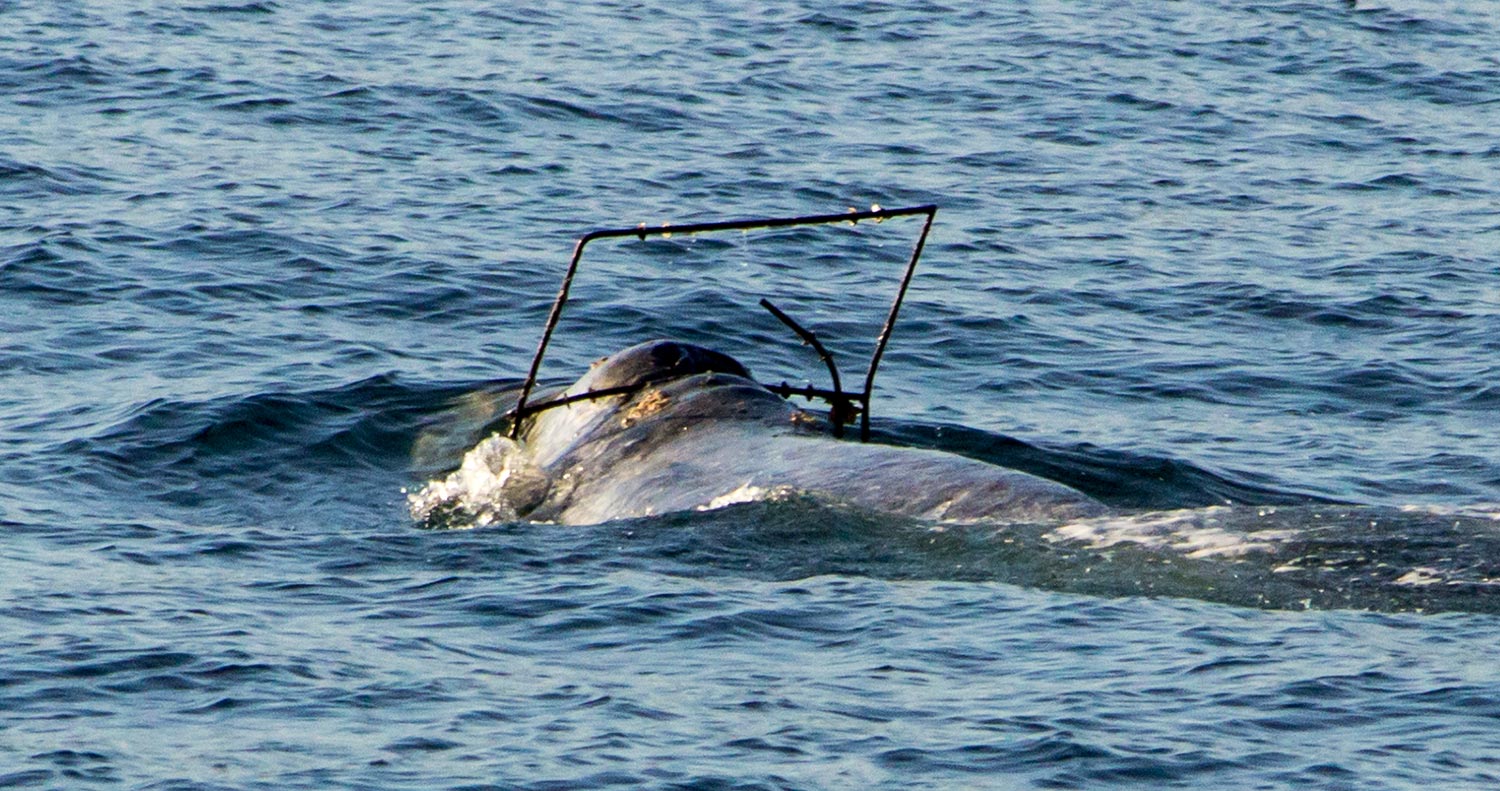Whale Entanglement Part 1: How Whales Become Entangled

All across the globe, an extraordinary amount of marine mammals are cruising about our vast and incredible oceans. Although these majestic and graceful creatures migrate, feed, and dwell amid some of nature’s most pristine locations, a catastrophic occurrence is taking place beneath the surface of the swells. This heartbreaking happening is the devastating reality of whale entanglement.
According to the National Oceanic and Atmospheric Administration, whale entanglement is when “Large whales periodically become entangled inactive or derelict fishing gear, or other ropes/lines/chains in the marine environment.” Sadly, large whales are not the only animals becoming entangled in neglected and active fishing gear, but whales, dolphins, and porpoises are common victims of this occurrence.
As the wild animals roam about our waters, they converge with fishing gear, fishing line, and fishing net, such as Dungeness crab traps, lobster traps, spot prawn traps, and gillnet fisheries.
Fishing lines and gear are placed in various locations in the ocean. Often, they will span across the length of a mile, reaching the bottom of the seafloor (similar to a curtain,) trapping and picking up a variety of living sea creatures that come into their paths.
These sea creatures range from whales, dolphins, birds, sea lions, crabs, and many more including members of the sea turtle species. As the sea creatures converge with the fishing material, the gear and lines get hooked or wrapped around a particular part of the animal. With the staggering number of wildlife trapped in these lines and gear, nearly 308,000 dolphins and whales are estimated die each year around the world.
Marine biologists, aquarium scientists and renowned researchers on the east coast are currently studying the North Atlantic right whale populations, a species teetering on the brink of extinction with only 440 animals left on the earth due to deaths from whale entanglement. With new computer technology, they are undergoing a series of simulator tests that help them to better understand how these magnificent mammals are becoming entangled.
Senior scientist at the New England Aquarium’s Anderson Cabot Center for Ocean Life, Tim Werner, stated that the “video simulation has helped his team better understand how whales unwittingly—and often lethally—wrap themselves in the fishing buoy lines that hang vertically in the ocean.” Furthermore, “The simulator shows how a whale might flinch as it strikes a rope, then instinctively corkscrew and roll—ending up with the line hopelessly wrapped around its body and flippers.”
Often, in an effort to separate themselves from the gear, the animals will become more entangled by the materials, making it difficult for them to shed the gear on their own.
Thankfully, some whales are able to dispose of the gear on their own, but in many instances, other whales are unsuccessful in doing so. This leaves a large majority of entangled whales swimming with material for long periods of time such as days, months and even years.
Depending on where the gear is located on the whales, it can prohibit feeding and cause extreme exhaustion as the dragging of debris and gear causes the animals to exert more energy. In many cases, entangled whales suffer from severe injury, malnutrition, infection and ultimately death.
In addition to the North Pacific right whale species, other members of the baleen whale family have been victims of whale entanglement, including entangled humpback whales, entangled gray whales, entangled fin whales, and entangled blue whales.
These whales are often found closer to home along the west coast of the United States in waters near Washington state, Oregon, and California. NOAA fisheries are currently conducting extensive research and reports to better understand why and how these whales are becoming entangled. Through their research, the number of whale entanglements reported has been astounding and increasing each year.
In the year 2018 alone, 48 whales were confirmed entangled along the coast of California, Oregon, and Washington, with central and southern California holding the most. From these entanglements, 34 were humpback whales, again making them the most common species of whales found to be entangled. An entangled gray whale, as well as 10 others, were found, along with a fin whale entanglement. Although one unconfirmed report was made of an entangled blue whale, not one confirmed blue whale entanglement was discovered in 2018, making it the first year since 2015.
Many of these whales were found during their annual migratory seasons, including gray whales who were found during the winter and spring months, and humpback whales who were reported during the summer and fall. As the gray whales make their way from their feeding grounds in the Arctic to the warm waters of Baja, Mexico, to mate and give birth, they travel along the west coast of the United States, resulting in these reports. On the other hand, humpback whales discovered off the west coast, migrate south along the coast to reach winter breeding grounds in Mexico and Central America.
While many entangled whales are reported along our coast due to their migratory routes, the reported locations may not necessarily reflect the original location of the entanglement. Further investigation has led researchers to correlate and confirm a large number of them with specific gear types and fisheries in the pacific along the states of Washington, Oregon, and California.
For example, in 2018, the 46 whales were reported entangled to professionals, coast guard members, and West Coast Region Marine Mammal Stranding Network partners. The California Dungeness crab commercial trap fishery was a confirmed source for seven humpback whale reports. In addition, five entangled whale reports, including three gray whales and two humpback whales, were sourced back to Washington Dungeness crab commercial trap fishery, including tribal fisheries.
Oregon Dungeness crab commercial trap fishery was tied to one gray whale and one humpback whale. In a state unknown, Commercial Dungeness crab commercial trap fishery was related to one humpback whale entanglement. One humpback whale was sourced to California commercial spot prawn trap fishery, while another humpback whale was sourced to California recreational spot prawn trap fishery. Gillnet fisheries were connected to a total of seven reports of whale entanglement, consisting of three gray whales and four humpback whales.
There are a number of fisheries that are related to the entanglement of large whales and other marine wildlife species, and at times, it seems particularly difficult to pinpoint the specific gillnet gear that is reported. Several other incidents have been reported, but due to the challenging nature of identifying both the source and the gear, it can be hard to trace the original origin/fishery.
Of a large number of entangled whales that were reported during the 2018 year, seven of the whales, including five humpback whales and two gray whales, were reported as dead, while all other reports involved live whales.
As several reputable organizations such as the National Oceanic and Atmospheric Administration, International Whaling Commission, and West Coast Region Marine Mammal Stranding Network continue to undergo extensive and thorough research to aid in the endeavor of resolving whale entanglements, the need for both education and awareness is key.
While the general public plays a great role in reporting these entanglements, it’s paramount that they are done in an appropriate manner. A whale spotted who seems to be entangled should be reported to the proper rescue team and response team, in order for them to assist in the correct way.
At times, in an effort to help distressed and entangled wildlife, many individuals who are not adequately trained and certified will take matters into their own hands. Although intentions may be pure, these animals are wild and can be unpredictable, and the steps taken to rescue them are intricate and specialized to the needs of the mammals.
Please join us in part two of our whale entanglement series where we will take a greater in-depth look at what happens when a whale is entangle, what these rescue teams do in order to assist them, and how bystanders can help entangled whales.
